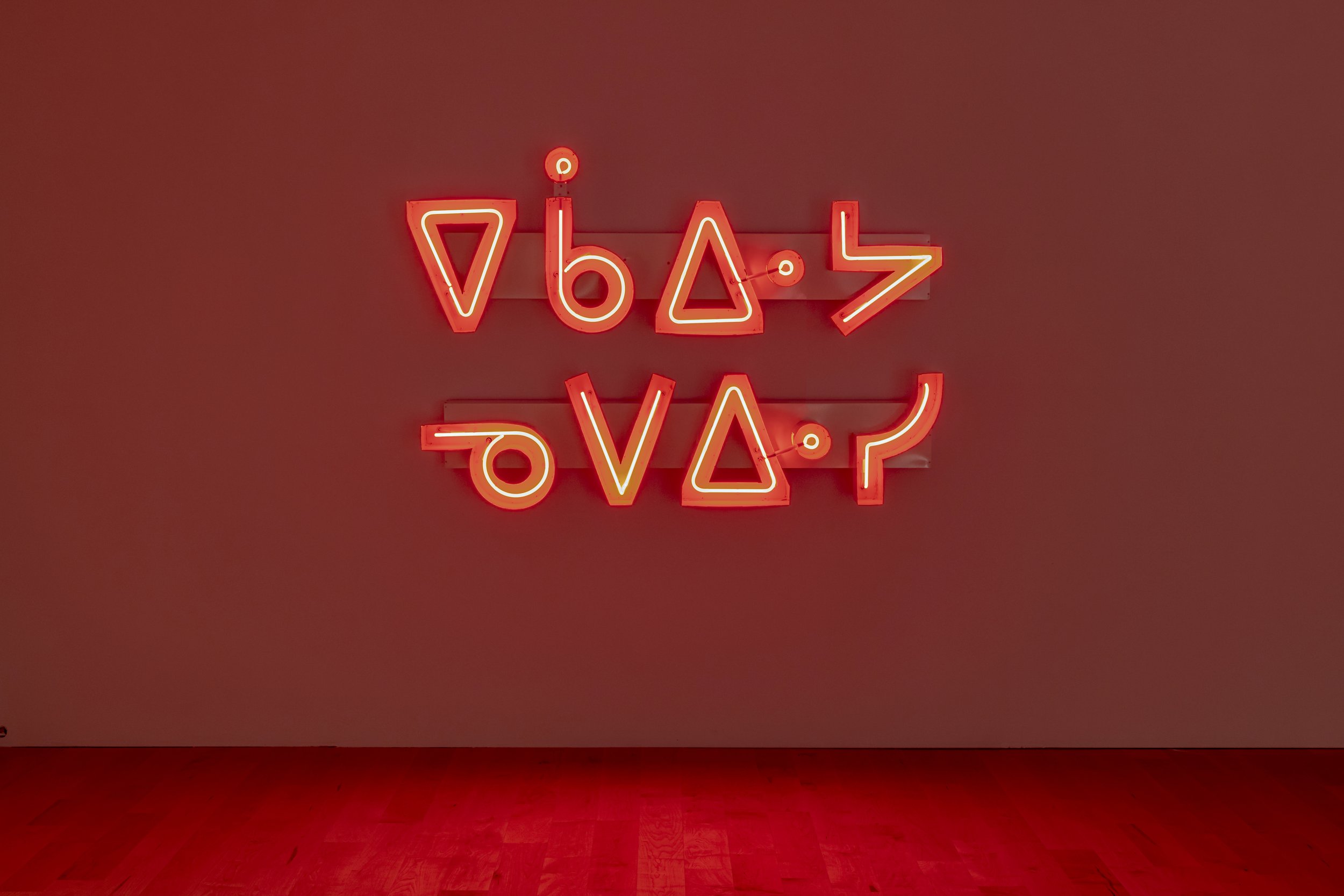
Joi T. Arcand, ēkāwiya nēpēwisi (don’t be shy), second edition, neon channel sign, 2019.
Photo: Tony Hafkenscheid
Taskoch pipon kona kah nipa muskoseya, nepin pesim eti pimachihew | Like the winter snow kills the grass, the summer sun revives it
curated by Missy LeBlanc, TRUCK Contemporary Art
Includes works from Joi T. Arcand, Richelle Bear Hat, Susan Blight, Tsēmā Igharas, Audie Murray, Michelle Sylliboy, and Alberta Rose W./Ingniq
November 4 to January 6, 2023
Opening: November 4, 2022
stay tuned for related programming announcements
Taskoch pipon kona kah nipa muskoseya, nepin pesim eti pimachihew | Like the winter snow kills the grass, the summer sun revives it features seven Indigenous artists who create work in an Indigenous language from each of the major geographic regions of what is now known as Canada—Anishinaabemowin, Komqwejwi'kasikl, Michif, nēhiyawēwin, Nitsiipowahsiin, Tāłtān, and Uummarmiutun. The exhibition celebrates and centres Indigenous language revitalization and ways of knowing. Taskoch pipon kona kah nipa muskoseya, nepin pesim eti pimachihew aims to address and initiate a discussion on how Indigenous languages intertwine with Indigenous epistemologies and how the dormancy and extinction of Indigenous languages leads to a hindrance of culture and knowledge. Bringing together emerging and established Indigenous artists based in so-called Canada, the exhibition gives space back to those artists whose practices deal with Indigenous languages in each of their visibilities, vulnerabilities, and regional voices.
Organized and circulated by TRUCK Contemporary Art. Support from the Canada Council for the Arts is gratefully acknowledged.
Audie Murrary, I recognize the ways you shift insides (Rugoru), mixed-media installation, 2021. Photo: Tony Hafkenscheid.
Joi T. Arcand (Cree, Muskeg Lake Cree Nation) is an artist currently residing in Ottawa, Ontario. She received her Bachelor of Fine Arts with Great Distinction from the University of Saskatchewan in 2005. In 2018, Arcand was shortlisted for the prestigious Sobey Art Award. Her practice includes photography, digital collage, and graphic design and is characterized by a visionary and subversive reclamation and Indigenization of public spaces through the use of Cree language and syllabics.
Richelle Bear Hat (Blackfoot/Dane-Zaa Cree, Siksika First Nation) is a Calgary based artist and graduated from the Alberta College of Art + Design with a Bachelor of Fine Arts in Drawing in 2011. She has since gone on to work with the Banff Centre for Arts and Creativity as a Collections Work Study, TRUCK Contemporary Art as Engagement Coordinator, and is currently a Studio Instructor at Indefinite Arts Centre. Bear Hat's artistic practice investigates ideas surrounding family relationships and the types of knowledge that are capable of being passed through them. Through the use of video, text, sound, and paper-based works, she employs materials and means of production to support transferences of memory and provide a platform for storytelling.
Susan Blight (Anishinaabe, Couchiching First Nation) is an interdisciplinary artist working with public art, site-specific intervention, photography, film and social practice. Her solo and collaborative work engages questions of personal and cultural identity and its relationship to space. Susan is Delaney Chair in Indigenous Visual Culture at OCAD University and an Assistant Professor in the Faculty of Arts & Science.
Tsēmā Igharas (Tahltan, Tahltan First Nation) is an interdisciplinary who uses Potlatch methodology as the foundation for the creation of compelling performance work and installations. Her practice is informed by Northwest Coast Formline Design, her studies in visual culture, and time spent in the mountains. Her unique approach is a way to challenge the colonial value system and relation to the land, and to promote, through methods of care, strategies of resistance.
Audie Murray (Métis) is a multidisciplinary visual artist; her art practice is process oriented and explores themes of contemporary culture and how this relates to experiences of duality and connectivity. This practice is a way to reclaim and work through various subject matter—much of it relating to the positionality of marginalized bodies living in an urban space. Raised in Regina, SK/Treaty 4 Territory, much of her family and familial histories are located in the Qu’Appelle region and Meadow Lake area of Saskatchewan. Murray holds a visual arts diploma from Camosun College and a Bachelor of Fine Arts from the University of Regina.
Alberta Rose W./Ingniq (Inuvialuit /settler) is a Moh’kins’stis (Calgary) based artist who obtained her Bachelor of Fine Arts in Painting with Distinction from the Alberta University of the Arts in 2016. She often creates work that reflects both aspects of her cultural identity as well as broader social issues relating to Indigenous people today.
Michelle Sylliboy (L’nuk) is a Two-Spirited artist and Assistant Professor in the departments of Modern Language, Education, and Fine Arts at St. Francis Xavier University in Antigonish, Nova Scotia. Sylliboy was born in Boston, Massachusetts and raised on unceded Mi’kmaw territory in the community of We'koqmaq, Cape Breton. She gathers much of her inspiration from personal tales, the environment, and her L'nuk (Mi'kmaq)culture. Her Interdisciplinary art practice has led her to work with emerging and professional artists from all over Turtle Island. Sylliboy is currently pursuing a Doctor of Philosophy in Education from Simon Fraser University. Her dissertation combines her artistic background and education by writing about her Mi'kmaq Komqwejwi'kasikl (glyphic) living curriculum.
Missy LeBlanc, Curator (Métis, nêhiyaw, and Polish) was born and raised in amiskwacîwâskahikan/Edmonton and is a disabled curator, researcher, and writer based on the Prairies where she is currently the Curatorial Resident at TRUCK Contemporary Art in Mohkinstsis/Calgary and a Senior Research Assistant on the SSHRC funded project, The Space Between Us, with the aabijijiwan New Media Lab at the University of Winnipeg on Treaty 1 Territory. In 2019, she was the winner of the Middlebrook Prize for Young Canadian Curators and a runner-up for the Canadian Art Writing Prize. LeBlanc holds a Bachelor of Arts from the University of Alberta, double majoring in the History of Art, Design, and Visual Culture and Sociology (2015) and a Diploma in Arts & Cultural Management from MacEwan University (2017). LeBlanc is currently pursuing a Master of Arts in Cultural Studies, Curatorial Practices from the University of Winnipeg.
Grounded in modalities of care and relationality, LeBlanc’s curatorial, research, and writing practice centers the voices and stories of those that have been exploited, ignored, and silenced by the historically white, patriarchal, heteronormative, and ableist art world. By providing platforms for people that have been marginalized to share their stories, LeBlanc aims to create and facilitate spaces and environments that will produce equitable and sustainable change within the arts and cultural sectors.
Taskoch pipon kona kah nipa muskoseya, nepin pesim eti pimachihew | Like the winter snow kills the grass, the summer sun revives it is presented alongside Mamanaw Pekiskwewina | Mother Tongues: Saskatoon, co-curated by Missy LeBlanc and Kiyari McNab for AKA Artist-Run.
Taskoch pipon kona kah nipa muskoseya, nepin pesim eti pimachihew | Like the winter snow kills the grass, the summer sun revives it is curated by Missy LeBlanc and is organized and circulated by TRUCK Contemporary Art and is presented in partnership with AKA Artist-Run.
This project was made possible with the support of the Canada Council for the Arts.


